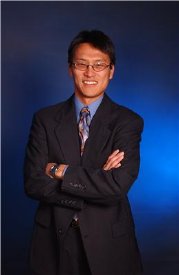Nov 21 2010
Accelerator-based supercomputers hold eight of the top 10 spots on The Green500 List, released yesterday. These supercomputers use dedicated hardware to perform computations faster than a typical central processing unit (CPU).
Accelerators also topped the June edition of the Green500 List. “One might argue that this year’s Green500 marks The Year of the Accelerator,” said Green500 co-founder Wu Feng, an associate professor with the Virginia Tech College of Engineering computer science and electrical and computer engineering departments.
 Wu Feng, associate professor of computer science and electrical and computer engineering at Virginia Tech, is the co-founder of the Gree500 List that lists the energy efficiency of supercomputers.
Wu Feng, associate professor of computer science and electrical and computer engineering at Virginia Tech, is the co-founder of the Gree500 List that lists the energy efficiency of supercomputers.
The Green500 has ranked the energy efficiency of the world’s 500 fastest supercomputers since its debut in 2007, serving as a complement to the well-known supercomputer industry marker TOP500.
Topping the Green500 is the IBM BlueGene/Q prototype supercomputer, the third in a series of energy-efficient Blue Gene supercomputers, following Blue Gene/L and Blue Gene/P. In a 2004 Top500 ranking, Blue Gene/L bested the powerful Japanese Earth Simulator, which itself created in 2002 a so-called “Computenik” event – a pun of the Soviet Union satellite Sputnik – by shattering the United States’ then unchallenged hold on the supercomputer industry.
Despite not making the No. 1 spot, the overall energy efficiency of accelerator supercomputers nonetheless dominated the overall Green500. The Tokyo Institute of Technology-based production supercomputer TSUBAME 2.0 holds the second spot on the latest Green500.
Accelerators have been making waves and headlines worldwide. At No. 11 on the Green500 is China’s Tianhe-1A supercomputer, deemed the world’s fastest supercomputer by the November Top500 list. Built at the National University of Defense Technology research lab in Tianjin, China, Tianhe boats 1.4 times the computing power of the United States’ then-top contender.
“What is scary about this is that the U.S. dominance in high-performance computing is at risk,” Feng told the “New York Times” in October upon Tianhe’s debut and its No. 1 ranking on the Top500. “One could argue that this hits the foundation of our economic future.”
“Accelerator-based supercomputers on the Green500 List produce an average efficiency of 573 Megaflops/Watts, whereas the other measured supercomputers on the list produce only an average efficiency of 206 Megaflops/Watts,” Feng said. “That makes the accelerator-based supercomputers on the Green500 nearly three times more energy efficient than their non-accelerated counterparts.”
Accelerator-based supercomputers come largely in two flavors: one is based on the commodity graphics processing unit (GPU) and the second is based on the custom PowerXCell 8i processor from IBM. The latter is an enhancement of the Cell Broadband Engine developed for the game console PlayStation 3, and includes a network of programmable units called field programmable gate arrays or FPGAs.
The Green500 List is released twice a year, in June and in November. To measure energy efficiency, Feng uses a Megaflops/W metric, or millions of floating-point operations per second (Megaflops) divided by Watts.